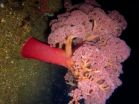(Press-News.org) This spring, scientists from the California Academy of Sciences braved leeches, lionfish, whip-scorpions and a wide variety of other biting and stinging creatures to lead the most comprehensive scientific survey effort ever conducted in the Philippines, documenting both terrestrial and marine life forms from the tops of the highest mountains to the depths of the sea. They were joined on this unprecedented, multi-disciplinary undertaking by more than two dozen colleagues from the Philippines, as well as by a team of Academy educators who worked to share the expedition's findings with local community and conservation groups. Over the course of the expedition, which was funded by a generous gift from Margaret and Will Hearst, the scientists discovered more than 300 species that are likely new to science, including dozens of new insects and spiders, deep-sea armored corals, ornate sea pens, bizarre new sea urchins and sea stars, a shrimp-eating swell shark, and over 50 colorful new sea slugs. These discoveries will be confirmed and described over the coming months, as the scientists use both microscopes and DNA sequencing to analyze their specimens.
"The Philippines is one of the hottest of the hotspots for diverse and threatened life on Earth," says Dr. Terrence Gosliner, Dean of Science and Research Collections at the California Academy of Sciences and leader of the 2011 Philippine Biodiversity Expedition. "Despite this designation, however, the biodiversity here is still relatively unknown, and we found new species during nearly every dive and hike as we surveyed the country's reefs, rainforests, and the ocean floor. The species lists and distribution maps that we created during this expedition will help to inform future conservation decisions and ensure that this remarkable biodiversity is afforded the best possible chance of survival."
Despite intensive efforts to document life on Earth, scientists estimate that more than 90 percent of the species on this planet have yet to be discovered. In the face of large-scale habitat loss and degradation, many of these species are disappearing before we even know they exist. As they join the ranks of the extinct, we are not only losing members of our family tree—we are also losing potential medical treatments, agricultural pollinators, oxygen producers, soil servicers, and many other critical components of healthy, functioning ecosystems. In order to make smart decisions about how to conserve what is left of our planet's biodiversity, we must make a concerted effort to rapidly increase our knowledge about these life forms and their distribution. This was the motivation behind the Academy's 2011 Philippine Biodiversity Expedition, which aimed to dramatically improve our understanding of one of the most species-rich places on Earth.
During their 42-day expedition to survey Luzon Island—the largest island in the Philippine archipelago—and its surrounding waters, the international team of scientists created species lists and distribution maps for a wide variety of species, including plants, insects, spiders, reptiles, amphibians, fish, corals, barnacles, sea urchins and many other marine invertebrates. Along the way, they encountered more than 300 species that appear to be new to science, including such notable finds as a cicada that makes a distinctive "laughing" call, a deep-sea swell shark that inflates its stomach with water to bulk up and scare off other predators, a starfish that exclusively eats sunken driftwood, three new lobster relatives that squeeze into crevices instead of carrying shells on their backs, a crab whose pincers are lined with needle-like teeth, and a worm-like pipefish that hides among colonies of soft coral. Many of the new species avoided previous detection because of their diminutive size, such as goblin spiders, sea slugs, and barnacles that all measure just a few millimeters in length. Others simply exist in places that are rarely, if ever, visited by humans, such as a snake eel from the bottom of the ocean and a primitive plant called a spikemoss from the dangerously steep upper slopes of Mt. Isarog. All of the new species add weight to the idea that the Philippines is a critically important haven for biodiversity, and that its waters likely house more species than any other marine environment on Earth.
Unlike the traditional expedition model, in which results are often not published or shared until months or years after the field work has concluded, the participants in the Academy's 2011 Philippine Biodiversity Expedition began the process of communicating about their results while they were still in the Philippines. With the help of a team of Academy educators, they conducted outreach sessions in each of the communities closest to the expedition's survey sites, sharing their preliminary findings with local teachers, politicians, and conservation workers. At the end of the expedition on June 8, they held a full-day symposium at the University of the Philippines to share these results more widely and discuss initial conservation recommendations. Since then, the scientists have integrated their data and provided a formal recommendation to key partners such as Conservation International, the Philippines Protected Areas and Wildlife Bureau, the Philippines Department of the Environment and Natural Resources, and the Bureau of Fishers and Aquatic Resources outlining the most important locations for establishing or expanding marine protected areas, as well as suggested areas for reforestation to reduce sedimentation damage to the reefs. They also identified reduction of plastic waste as a conservation priority, since plastic litter was pervasive throughout the marine environment, even on the ocean floor at depths of over 6,000 feet. Additionally, the team's terrestrial surveys and species lists will help UNESCO and other conservation organizations make a compelling case for funding to enforce the existing protected areas on land, many of which are currently only "paper parks" with no means of preventing deforestation, hunting and other technically prohibited activities.
Over the next few months, the expedition scientists will be hard at work analyzing the specimens they collected during their field work—and undoubtedly discovering more new species along the way. In the meantime, they will present their preliminary results to the San Francisco public for the first time on June 30, during the Academy's weekly NightLife event.
INFORMATION:
About the California Academy of Sciences
The California Academy of Sciences is an international center for scientific education and research and is at the forefront of efforts to understand and protect the diversity of Earth's living things. The Academy has a staff of over 50 professional educators and Ph.D.-level scientists, supported by more than 100 Research and Field Associates and over 300 Fellows. It conducts research in 11 scientific fields: anthropology, aquatic biology, botany, comparative genomics, entomology, geology, herpetology, ichthyology, invertebrate zoology, mammalogy, and ornithology. Visit research.calacademy.org.
More than 300 new species discovered in the Philippines by California Academy of Sciences
Scientists find additional evidence that the Philippines is one of the most species-rich places on the planet; provide recommendations for conservation
2011-06-25
ELSE PRESS RELEASES FROM THIS DATE:
Introducing Pinpoint, the Easiest Way to Point, Store, & Share Your Personal Locations
2011-06-25
Pinpoint, LLC announces the launch of Pinpoint, an innovative web application that allows people to point, store, and share their personal locations with the world.
Pinpoint will save businesses and people time by enabling them to create pins on a map. Users can give each pin its own customized URL, which makes referring back to a particular place easier than ever!
Businesses can also use their office pin as an alternative to their postal address.
"I invented Pinpoint when I found myself searching the same place over and over again on Google Maps and sending ...
Humpback whales catch prey with bubble-nets
2011-06-25
Marine biologist David Wiley of the National Oceanic and Atmospheric Administration (NOAA) and others report in the latest issue of Behaviour (Volume 148, Nos. 5-6) how humpback whales in the Gulf of Maine catch prey with advanced water technology. Humpback whales (Megaptera novaeangliae) are large baleen whales (up to 14 m long) that feed on a small prey in dense concentrations, such as krill or herrings.
Humpbacks whales have large flukes relative to their size providing greater thrust for quick maneuvers. While other baleen whales feed by swimming rapidly forward, ...
Pollinators make critical contribution to healthy diets
2011-06-25
Fruits and vegetables that provide the highest levels of vitamins and minerals to the human diet globally depend heavily on bees and other pollinating animals, according to a new study published in the international online journal PLoS ONE.
The new study was carried out by an interdisciplinary research team, comprised of pollination ecologists and a nutrition expert, based at the Leuphana University of Lüneburg, the University of Berlin in Germany, and the University of California at Berkeley and San Francisco. The research team showed that globally "animal-pollinated ...
URALCHEM Holding P.L.C. Reports the First Quarter of Year 2011 IFRS Financial Results
2011-06-25
URALCHEM Holding P.L.C., one of the largest producers of nitrogen and phosphate fertilisers in Russia, today announced its unaudited IFRS financial results for the 1st Quarter of 2011 ending 31 March 2011.
- Revenue increased to US $ 566 million, compared to US $ 325 million in Q1 2010
- Operating profit increased to US $ 160 million, compared with US $ 39 million in Q1 2010
- Adjusted EBITDA grew to US $ 186 million, compared to US $ 66 million in Q1 2010
- Net profit amounted to US $ 161 million compared to US $ 19 million in Q1 2010
URALCHEM Holding P.L.C. (hereinafter ...
A New Car Hire Competition Launched By Carrentals.co.uk
2011-06-25
Over the next eight weeks, eight lucky customers of Carrentals.co.uk, the leading comparator for car hire, will win their hire car booking for free.
The lucky winners will be drawn at random, every Tuesday, and be announced on the Facebook page of Carrentals.co.uk. The competition is called 'Carrentals.co.uk 8 Weeks Car Hire Give Away' and for those customers who book their rental car online either by the Facebook App or on the main site, they will be entered into the draw automatically.
"The competition is fantastic for those looking to save a some money this ...
Singapore scientists discover how to control fate of stem cells
2011-06-25
Scientists from the Genome Institute of Singapore (GIS), an institute of the Agency for Science, Technology and Research (A*STAR), in collaboration with the Cancer Science Institute of Singapore (CSI), have discovered how the body uses a single communication system to decide the fate of stem cells. The study, published in the scientific journal PLoS Genetics on 23rd June 2011, paves the way for the development of new methods of stem cell therapy with fewer side effects.
Dr Kian Leong Lee and his team of scientists studied how a single signaling system known as the Nodal/Activin ...
Precise assembly of engines
2011-06-25
This release is available in German.
Valves, nozzles, pistons, spark plugs and camshafts – the heart of each car is its engine. It is a complex structure with many levels and individual parts and must therefore be assembled in a correspondingly precise way. Parts that are slightly damaged, malformed or assembled the wrong way can cause engine damage. The results would be an angry customer and damage to the reputation of the car manufacturer.
While assembly is mostly automated for the construction of the body, the engine is still assembled by hand over long stretches. ...
New Jersey Institute for Continuing Legal Education; The Changing Culture of ADR: From the Court House and Beyond
2011-06-25
The 14th annual conference is the premier, daylong, and statewide conference for Alternative Dispute Resolution professionals: negotiators, mediators, arbitrators and neutral experts, with special presentations and interactive workshops on today's cutting-edge ADR issues.
It is a "must attend" event for all attorneys, arbitrators, mediators and other professionals who want to enhance their conflict management techniques.
The Conference Sessions are taught by highly authoritative national and state experts, providing proven practice tips, CLE credits, and ...
Crafting a Parenting Plan for Unwed Parents
2011-06-25
Making arrangements for child custody and visitation can be difficult in the best of situations, but even more so if the parents are unmarried. Unwed parents have to work even harder to ensure that the best interests of their children are protected when making decisions about child custody and parenting time (perhaps better known as "visitation"). Since roughly 40 percent of children are now born out of wedlock, issues surrounding parenting plans for the children of unmarried parents are more important than ever.
While it is always advisable to craft a comprehensive ...
Optical circuit enables new approach to quantum technologies
2011-06-25
Professor Jeremy O'Brien, Director of the University of Bristol's Centre for Quantum Photonics, and his Japanese colleagues have demonstrated a quantum logic gate acting on four particles of light – photons. The researchers believe their device could provide important routes to new quantum technologies, including secure communication, precision measurement, and ultimately a quantum computer—a powerful type of computer that uses quantum bits (qubits) rather than the conventional bits used in today's computers.
Unlike conventional bits or transistors, which can be in one ...
LAST 30 PRESS RELEASES:
School meals could unlock major gains for human and planetary health
Menopause hormone therapy does not appear to impact dementia risk
Signature patterns of brain activity may help predict recovery from traumatic brain injury
Dresden study uncovers new key mechanism in cancer cells
New species are now being discovered faster than ever before, study suggests
Cannabis-based products show limited short-term benefit for chronic pain, with increased risk of adverse effects
Cannabis products with more THC slightly reduce pain but cause more side effects
Clearing the brain of aging cells could aid epilepsy and reduce seizures
Brain injuries linked with potential risk of suicide, new study finds
New technique lights up where drugs go in the body, cell by cell
New study finds movement of fishing fleets can reveal shifts in marine ecosystems
Embargoed: New evidence points to potential treatment for vascular dementia
Study uncovers disrupted brain balance in alcohol dependence
Working in groups can help Republicans and Democrats agree on controversial content moderation online
Structural findings reveal how distinct GPCR ligands create different levels of activation
Anything-goes “anyons” may be at the root of surprising quantum experiments
UC review: Maximizing workplace opportunity for veterans
From generation to complex control: Metasurfaces make perfect vortex beams "within reach"
Thin-film lithium niobate-based detector: recent advances and perspectives
Exploring why some people may tend to persistently make bad choices
How cells balance their protein levels
Nirsevimab vs RSVpreF vaccine for RSV–related hospitalization in newborns
Effectiveness and impact of maternal RSV immunization and nirsevimab on medically attended RSV in US children
AI gives scientists a boost, but at the cost of too many mediocre papers
Next-generation vision model maps tree growth at sub-meter precision
Genes aren’t destiny for inherited blindness, study shows
MIT study: High-fat diets make liver cells more likely to become cancerous
Exposure to multiple fine particulate matter components and incident depression in the US Medicare population
Risk of burdensome health care spending over time in the US
Nirsevimab against hospitalizations and emergency department visits for lower respiratory tract infection in infants
[Press-News.org] More than 300 new species discovered in the Philippines by California Academy of SciencesScientists find additional evidence that the Philippines is one of the most species-rich places on the planet; provide recommendations for conservation


